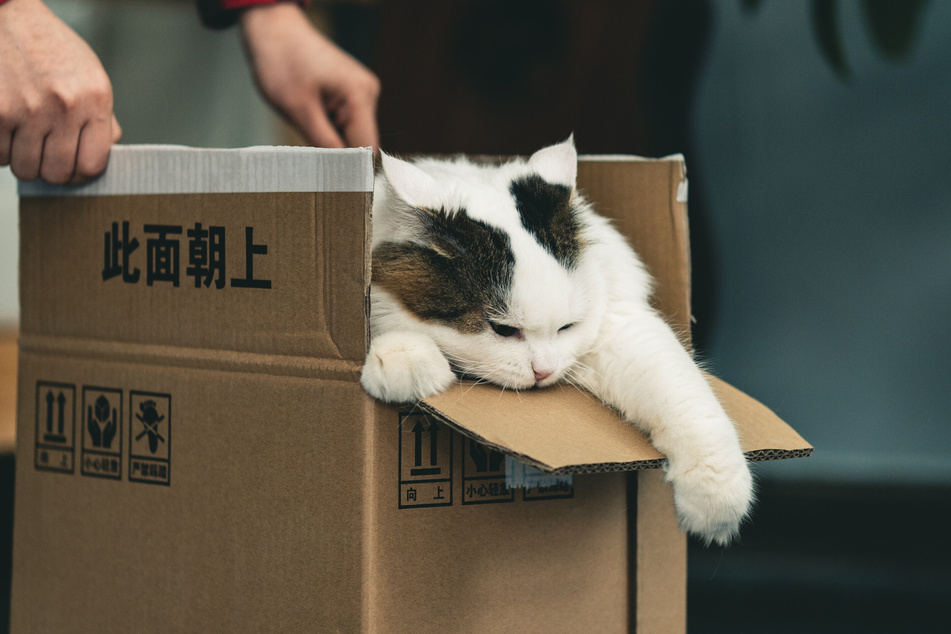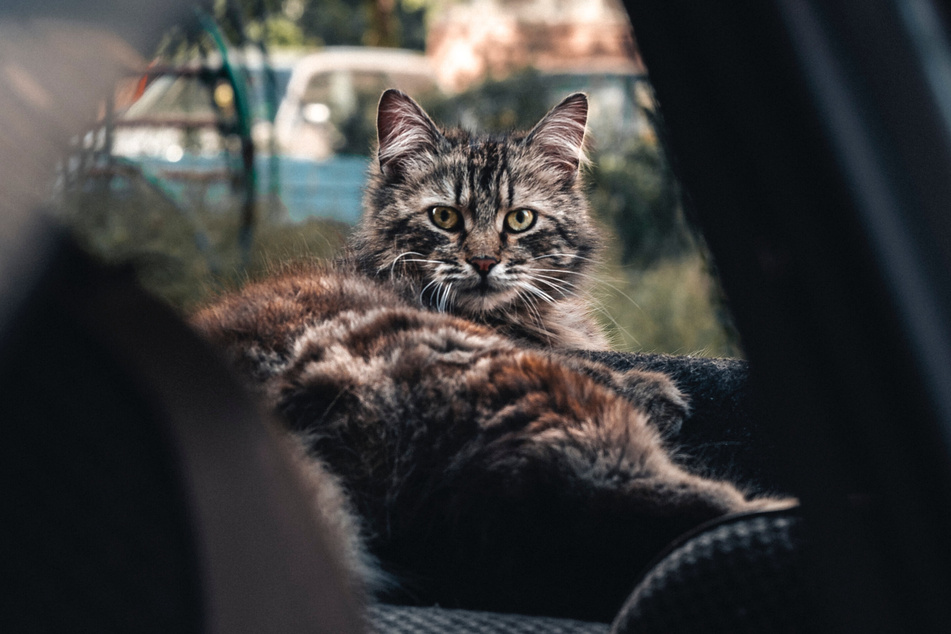Moving with cats: How to get a cat used to a new home
When you move to a new apartment or house, your cat can become incredibly anxious and unhappy. How can you make moving easier for your cat, and how can you help them adjust to their new home?

It's chaotic when you move, whether you're a cat, a donkey, or a human. For these little feline friends, though, moving is even more stressful. A change in environment, a completely new smellscape, and a different set of comforts and anxieties are all things that will make your cat's life difficult. So, how can you make things at least a little bit better?
In this cat guide, TAG24 will dive into how to move with a cat. How can you make your cat more comfortable, and help it adjust, when and after you move? It's time for some tips and tricks!
Tips for moving with cats
The key to a successful and relatively stress-free move is to keep things simple, to do things over a long period of time, and to make sure that everything and everyone gets moved safely. Sadly, moving with a cat can be particularly difficult and traumatic for your furry friend. So how can you make it easier?
Here are a few tips to help you move with a cat...
Tip 1: Keep things calm and peaceful, keep everyone happy, and surround your beloved feline friend with that same positivity. If it doesn't feel the impending stress in your household then the lead-up to moving won't be as horrible.
Tip 2: Take it on a few trips, put it in its box, and drive around the block a few times. When it arrives back in your home, give it a snack and some pats. After this has been done a few times, your cat will not have such a visceral and negative emotion to this process.
Tip 3: If possible, have a room that is fully cleared of furniture (except for somewhere comfortable for snoozing) and keep your cat inside. Make sure the movers know not to enter that room, and continue to keep your cat away from everything that's going on until you pick it up and plop it in its box. This will reduce its stress and make it less likely to freak out from all the banging, crashing, strangers and strangeness.
Tip 4: Make sure to reduce your cat's feed in the days before you move, so that there is less in its stomach and it is less likely to get sick during the car journey.
Tip 5: Especially anxious cats can panic in the hustle and bustle of moving. As previously mentioned, it is important to inform your movers about your cat so that they know to try and avoid it as best they can. Possibly even more importantly, though, talk with your vet about other options for helping your cat get through the process.
Tip 6: If your cat is going to really struggle during the moving process, maybe put it in a pet hotel until the movers have finished moving everything out, and pick it up on your way to the new place.
Keep in mind that situations change, though, and that your cat is not as adaptable as you are. It will get stressed out and anxious no-matter what, so the trick is to try and reduce the potential trauma it faces. Whatever you can do to help it through this process, the better.
Moving cross-country and long distances with cats
When the moving van is at your door and the process begins, it's all systems go until you're all unpacked and sitting down for a nice hot chocolate at the other end. You want to be fully prepared at this stage, and that means your cat, as well. When moving across the country, especially by car, this becomes even more important!
Here's how best to move with your cat by car...
Tip 1: Everyone involved should know that your four-legged friend is present, and someone should try and stay with the cat throughout this entire process. That means while the van is being packed, when in the car or making pit-stops, and while unpacking that same van at the end of the move.
Tip 2: To make sure that your kitty doesn't have to remain in the vehicle for an unnecessarily long period of time, you should make sure that a room is designated as their space during the move. In that room you should have somewhere for them to sleep, their litter box, some water, and some food.
Tip 3: Never allow your cat to be packed into the van. Indeed, they're in a box and it may seem convenient, but this will frighten the living daylights out of them. Even if it needs to be placed on a lap, your cat needs to be moved in the car with its humans.
If possible, it's best that their box is covered with some kind of blanket or towel. Keep them in a dim and quiet space, that's not too hot and not too cold, and make sure that they are constantly in the presence of a human.

Moving overseas with cats
The thing about moving overseas with your cat is that, well, you can't really practice such a thing. Of course, if you're driving over the border into Canada, or down south into Mexico, you can practice driving. Anywhere else, though, and let's be real, you're going to need to fly. Let's give some advice on that...
Here's what to consider when moving your cat overseas on a plane:
Tip 1: You're quite likely to need a valid health certificate from your veterinarian for your cat to be allowed onto the airplane. It will need to be fully vaccinated, properly healthy, and without any potentially infectious diseases.
Tip 2: In many countries, your cat will need to be kept in quarantine before it's allowed to come home. Check the requirements of your destination, and figure out how this will work.
Tip 3: Check with your airline about whether you can take the cat with you into the cabin, or whether it will need to be put in the hold.
Tip 4: Make sure that you are thorough and follow all the recommendations and requirements that your airline is asking for or suggesting.
Tip 5: Don't send your cat through the x-ray machine in its box. You need to pick it up and hold it in your arms as you walk through. This can be particularly traumatizing, so make sure that you have a firm grasp and attach a collar and leash so that it won't get far if it wrestles out of your arms.
Flying with a cat is not the same as flying with a dog. They are much more nervous animals, and will find the airport extremely stressful. Beware of this fact and, if possible, avoid this situation.
Moving an older cat to a new home
Moving with an older cat is particularly difficult, but not all that different to moving with a younger and healthier kitty. The key difference is that you need to go slower, be more cautious, and absolutely avoid moving countries or taking your cat on any form of public transport - whether that be an airplane or a train.
Here are some tips for moving with an old cat:
- Keep your older cat away from any packing that's going on, where possible.
- Give it more food than you would other cats, to keep its strength up.
- Keep the movers completely away from an older cat, as the fear can be incredibly dangerous for its health.
- It is even more important to keep an older cat supervised at all times during a move.
- Consider moving your older cat earlier than everything else and do things in stages, so that it isn't all done in one big jump.
The word of the day here is caution. Older cats are at a high risk of stress-related health issues. You want it to live as long as possible, into the future. So be careful.
How to help a cat adjust to a new home

The move doesn't end once a food bowl is in front of your kitty and it has a nice, comfortable bed to lie on with its humans. Cats are nervous and uncomfortable creatures, and will continue to suffer even long after your kitty has arrived. It will take a while for it to settle in, and you need to be prepared for this reality.
It's important to help your cat settle in when you move, here's how to acclimatize your cat to its new home...
Tip 1: When you arrive, you should continue the process of keeping your cat in a separate room during the move in as well. That means separating it from the movers, keeping it company, and making sure that it's comfortable during the hustle and bustle.
Tip 2: Before your new home has been fully organized and unpacked, your cat shouldn't be left home alone. It needs time to acclimatize, try doing this one room at a time.
Tip 3: When furnishing a room, make sure that it is relatively similar and familiar to your kitty. Keep those same bookshelves and couches, the blankets in similar positions, and its cat tree easily accessible.
Tip 4: Once your new home has been halfway furnished, you should allow the cat to explore. Keep it in a few specific rooms at the start, one of which should be your bedroom, and as things progress and it becomes more comfortable with each space, expand its horizon a little bit.
Tip 5: Once your cat's things have all been unpacked and placed in their positions, make sure that you show it where these things are. That means its cat tree, its blankets, litter box, food bowls, etc. One great idea is to literally show them to your cat as you unpack each item. This should all be done within the first few hours.
Tip 6: If your cat is an outside cat, make sure that it is fully used to the new house itself before you let it explore the great unknown. It needs to feel like this new home is its home and its territory. That means giving it at least 1–2 months before you let it outside. On top of that, for the first month that you let it outside, make sure that you are with it at all times when it is out of the house. This is a risk factor, as your cat could run off in search of its old territory.
Tip 7: In the meantime, make sure that your cat has been given plenty of activities, food, affection, pats, and love while it's stuck inside. You want to keep it comfortable and happy, and reduce its anxiety as well as its restlessness.
Tip 8: Once you are letting your cat outside again, don't feed it at all in the morning before you let it out. Start feeding your cat only once it comes home, to continually reinforce that this is its home and to disincentivise running away.
Important: If your kitty gets sick and stays in poor health for a while after moving house, it should be taken to the veterinarian and checked out as soon as possible.
Moving can be traumatizing for cats
Cats are gentle beasts, and have a very delicate temperament that's capable of being shattered in an instant. If you notice that your cat is suffering from increased anxiety and separation anxiety due to the move, it's important to get the advice of veterinarian and take action to improve your kitty's life.
In the end, though, while it will take a bit of time for your cat to adjust after a move, if you do it right then the process will not be too traumatic. Keep it as stress-free as possible, and treat your cat with affection and love!
Cover photo: 123RF / Irinagutyryak



